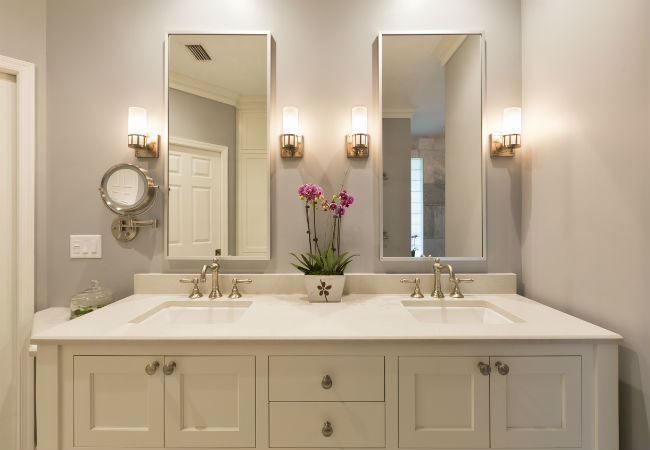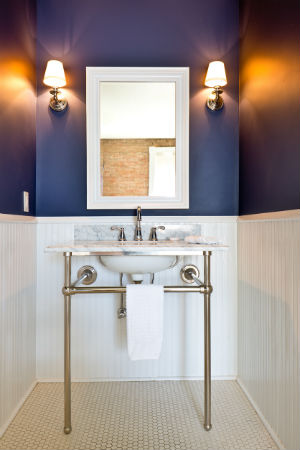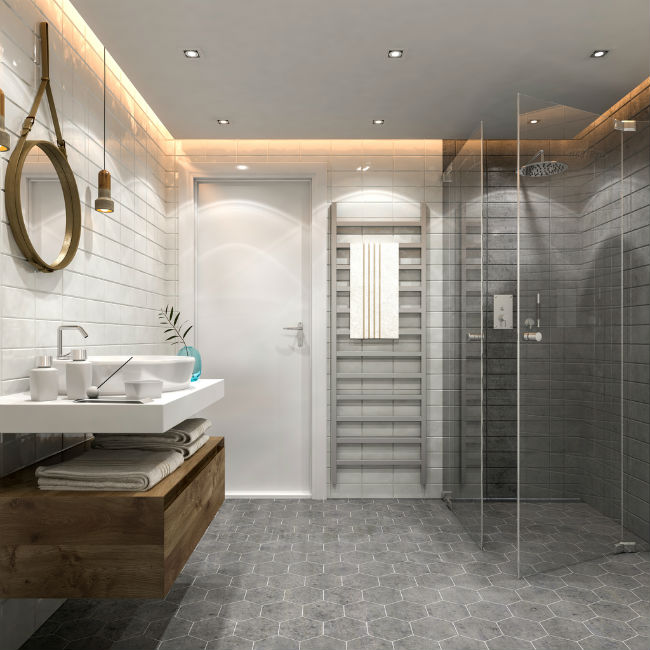

We may earn revenue from the products available on this page and participate in affiliate programs. Learn More ›
Q: I’m redoing my master bath and am overwhelmed by illumination options. How do I decide on the best bathroom lighting design for my needs?
A: Lighting design that enhances décor and aids in your ablutions can make the bathroom a more versatile, attractive space for everyday “me time.” But there’s quite a spectrum of bathroom lighting design choices, including fixture type, style, and placement, color, and illumination output needs. Ahead, all the info you need to achieve the best lighting for your personal space.
RELATED: 16 Brilliant Lighting Ideas You Can DIY on a Dime
Choose fixtures based on function.
Light fixtures play one of three roles in a bathroom: ambient, task, or accent lighting. Take your specific needs into account, choosing fixtures designed to serve those functions.

- Ambient lighting, usually soft overhead lighting, acts as the main source of illumination in a bathroom. Ambient light fixtures include recessed lights mounted inside shallow openings in the ceiling, flush-mount fixtures that mount to the ceiling with a small gap between the fixture and the ceiling, and ceiling fans with attached lights.
- Task lighting, brighter illumination usually restricted to a small area such as beside the sink mirror, helps you perform for detail-oriented tasks like applying makeup or shaving. Wall sconces, pendant lights that hang from the ceiling, and track lights (long multi-bulb tracks that can be mounted to a wall or ceiling) are commonly used as task lighting.
- Accent lighting falls between ambient and task lighting in brightness and is used to accentuate architectural details or showpieces. Examples include cove lights built into the ledges of a ceiling, mirror lights (bulbs that frame the outline of a mirror to backlight it), and rope lights (flexible, rope-shaped circuit boards with built-in bulbs).
Take a layered approach.
Single-function lighting might suffice for a half bath, but in standard or master bathrooms used for multiple purposes, one type of lighting will result in zones that are overly bright or dim for a given activity. To avoid this, employ a layered lighting design that incorporates fixtures from all three functional areas. For example, in a master bathroom, the best bathroom lighting design might feature recessed ambient lighting, pendants for tasks, and rope lights in the toe-kick area at the base of a bathroom cabinet as accents.
RELATED: 8 Common Lighting Mistakes Almost Everyone Makes
Calculate light output requirements based on size and functional area.
The Illuminating Engineering Society (IES) Lighting Handbook recommends between 20 and 50 lumens (a measure of light output) per square foot in the bathroom. Aim for 40 to 50 lumens per square foot in the task area where you’ll need the most light, a more moderate 30 lumens per square foot in areas that require accent lighting, and a softer lighting of 20 lumens per square foot or ambient lighting.
To determine how many bulbs to buy to meet your light output needs, multiply the lumens guideline by the square footage of the functional area. Let’s say you need 650 lumens to supply task lighting for a 13-square-foot vanity (50 times 13). Using the Energy Star lumens-to-watts conversion chart to work out the equivalent bulb wattage, you can see that a single 60-Watt incandescent bulb supplies 800 lumens of light output—more than enough for your needs. To lower your electricity bills, use an energy-saving 10-Watt LED or 14-Watt compact fluorescent light (CFL) bulb to deliver the same 800 lumens. The packaging of LED or CFL bulbs may only state the lumens rating, in which case you can simply look for a bulb that delivers 650 lumens of output (or use two 325-lumen LED or CFL bulbs).
Make sure that the total wattage or lumens of all the bulbs you install in a fixture doesn’t go over the maximum rating of the fixture (most fixtures will note the rating on the package), or you risk sparking a fire or damaging the fixture’s lightbulb sockets or wiring. For example, if a fixture has a rating of 75 Watts, a 60-Watt Incandescent bulb would work, but two 40-Watt Incandescent bulbs would exceed the threshold.
Position each fixture based on its type and function.
Ideally, ambient lighting will cast light evenly onto all four corners of the bathroom. So if you choose, for example, a ceiling fan light assembly or a flush-mount fixture, mount it to the center point of the ceiling. If mounting multiple recessed lights, install a single light in the middle of the ceiling and work your way outwards for the remaining lights, leaving a distance between the lights amounting to half the height of the ceiling (e.g., space lights five feet apart in a room with a 10-foot ceiling).
Task lighting should shed light on your face during grooming, which makes side lighting your best bet. Wall sconces that act as task lighting should optimally be mounted at eye level (roughly 60 inches above the ground for the average adult) on either side of a mirror above the vanity. Positioning either a recessed light or a wall sconce that consists of one bar of light above the vanity is a poor choice because it will cast shadows under your eyes; instead, mount a multi-bulb wall sconce or track light above the vanity (75 to 80 inches above the ground) so that light falls across your face in a continuous stream that minimizes shadows.
Position accent lighting to capture the most flattering details of the object it’s meant to accentuate. You might position a pendant light directly above the basin of an old-fashioned vessel sink to show off its vintage charms, or install a wall sconce at an angle above the shower to cast light directly onto a section of decorative tiles.

Choose from styles that synch with the existing space.
Bathroom light fixtures come in a variety of styles and finishes, be they flush-mounts with a dome-shaped shade made of frosted or clear glass, wood or stone teardrop pendant lights, or lengthy track lights finished with brushed nickel, bronze, or chrome. When choosing between these options, take an inventory of the existing appliances and hardware in your bathroom, including tub and shower materials, door knobs, cabinet and drawer pulls, and sink and tub faucets. Opt for light fixtures with a similar look for a sophisticated, seamless effect. Or incorporate a complementary style not already present in the bathroom—for example, dark wood pendant lights in an industrial-style bathroom with black appliances—for an unexpected, yet still cohesive, aesthetic.
Choose bulbs that emit white-colored light.
To capture your skin, hair, and outfits in detail and with a similar color accuracy as in daylight, opt for incandescent, LED, or CFL bathroom light bulbs with a color temperature of 3500K-4100 Kelvins (K) (usually labeled “Cool White/Bright White” on the packaging) or 5000K-6500K (labeled “Daylight”). Additionally, look for bulbs with a Color Rendering Index (a measure of how well a bulb can illuminate the full spectrum of colors) of 90 to 100, where a value of 100 is the CRI of daylight at midday.
Keep electrical safety in mind.
Using safe wiring practices is imperative when installing new light fixtures in the water-prone turf of the bathroom, as moisture that comes into contact with internal light fixture components or light switches can cause electrocution or short circuits that lead to fires. The circuit that supplies power to light fixtures in the bathroom should be separate from those that supply power to outlets used for other electronics in the bathroom (e.g., hair dryers and curling irons). Light switches should be grounded so that they divert stray voltage directly to the ground rather than through you. Lastly, bathroom lighting fixtures should be wet-rated (usually, this means the wires of the fixture are protected by metal.)
